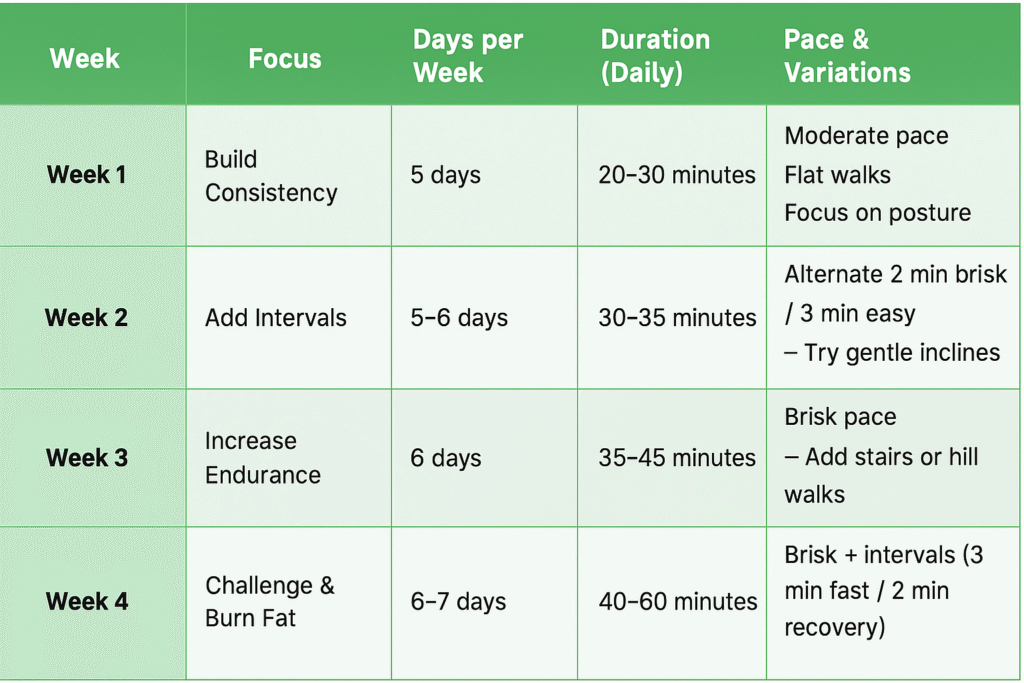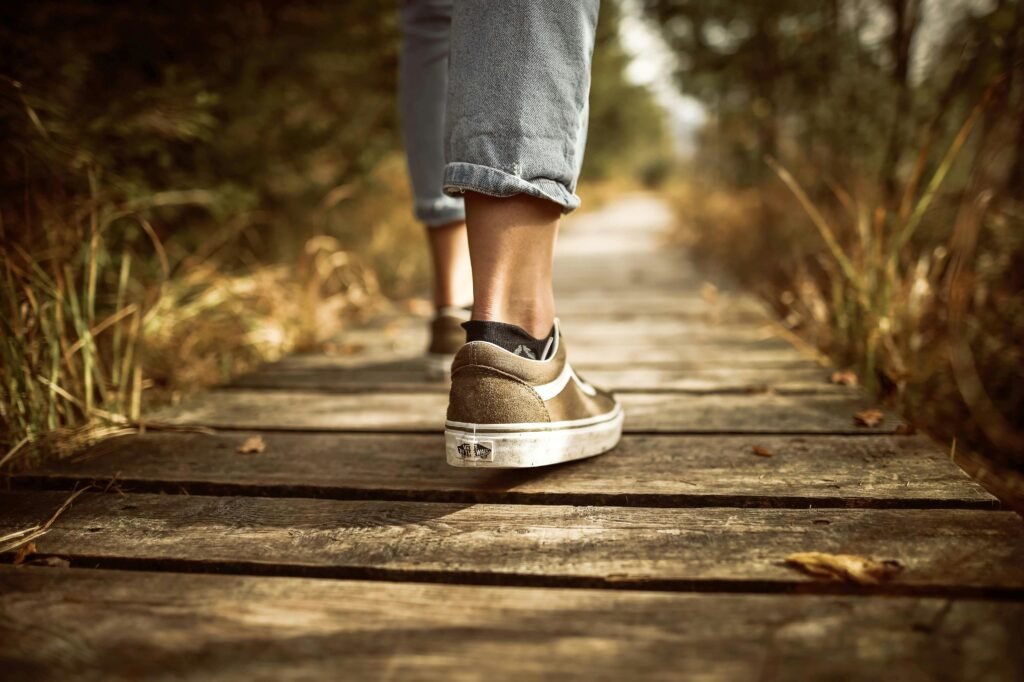Introduction:
Looking for a simple, free way to lose weight? This 28-Day Walking Plan for Weight Loss is designed for anyone who wants a realistic, no-fuss approach to getting fitter. Whether you’re just starting your fitness journey, returning after a break, or simply looking for a structured plan that fits into a busy schedule, this program is for you. Best of all, it’s completely free and can be done anywhere — all while being gentle on your joints.
This is one of the best walking plans to lose weight — and you can do it without stepping foot in a gym or investing in expensive equipment. Walking is simple, low-impact, and surprisingly effective when done consistently. In fact, walking regularly can boost your metabolism, improve your mood, and help shed unwanted pounds — no gym required!
Top 5 Benefits of Walking for Weight Loss
Walking may seem simple, but it’s one of the most effective and sustainable ways to lose weight and boost your overall health—both physically and mentally. Whether you’re just starting your weight loss journey or looking for a no-gym, no-equipment, low-stress workout that fits into your walking weight loss plan, here’s why walking deserves a spot in your daily routine:

1.Walking Burns Calories and Helps You Lose Weight
Regular walking increases your body’s energy expenditure, which helps you create a calorie deficit, the key to weight loss.
- 🔥 A 30-minute brisk walk can burn between 150 to 250 calories, depending on your weight, pace, and terrain.
- 🧠 According to Harvard Health Publishing, a 155-pound person can burn about 149 calories walking at a moderate pace for 30 minutes.
- 🏃♀️ The more frequently and briskly you walk, the more calories you burn—making walking a foundational tool for fat loss.
✅ Practical Tip: Aim for 7,000 to 10,000 steps per day for steady fat-burning benefits.
2.Boosts Your Metabolism Naturally
Walking stimulates several bodily systems that help improve your metabolism—even after your walk is over.
🔁 Engaging in daily walks helps regulate blood sugar, reduce insulin resistance, and increase muscle activity, all of which contribute to a more active metabolism.
🧬 A study published in the Journal of Applied Physiology showed that regular low-intensity aerobic activity like walking can increase fat oxidation and improve metabolic flexibility.
✅ Practical Tip: Try walking after meals—studies show this can help reduce blood sugar spikes and improve digestion.
3.Gentle on Joints, Ideal for Beginners
Unlike high-intensity workouts like running or jumping, walking is a low-impact activity, which makes it suitable for all ages and fitness levels.
🚶🏻 Walking reduces the strain on knees, ankles, and hips, making it a safer choice for overweight individuals or those with arthritis.
👟 You don’t need any equipment—just a comfortable pair of shoes and a safe walking space.
✅ Practical Tip: Start with short 10-minute walks and gradually build up to 30-60 minutes daily.
4.Walking Supports Mental Health and Reduces Stress
Walking isn’t just good for your waistline—it’s a proven way to boost your mental well-being.

🌿 Exposure to nature during walks helps lower cortisol levels (the stress hormone), reducing anxiety and mental fatigue.
😊 Walking increases the release of endorphins and serotonin, which promote better mood and reduce symptoms of depression.
🧠 Research shows that even a brief 10-minute walk can significantly improve mood, attentiveness, and confidence, according to a study highlighted by InnerDrive. This simple activity enhances mental clarity by increasing blood flow and releasing mood-boosting chemicals in the brain.
For more ways to improve your mental and physical well-being, explore our expert-backed fitness and wellness tips — designed to support sustainable weight loss and a healthier lifestyle.
✅ Practical Tip: Try walking in the morning sunlight or during your lunch break to clear your mind and lift your spirits.
5.Improves Sleep Quality and Daytime Energy
Good sleep is essential for weight loss, and walking can help regulate your sleep cycle.

💤 A study in Sleep Health Journal found that participants who walked daily experienced longer and deeper sleep compared to those who were sedentary.
⚡ Walking increases blood flow and oxygen to your muscles and brain, leading to better energy levels throughout the day.
✅ Practical Tip: Evening walks can help you unwind and prepare your body for restful sleep, while morning walks reset your circadian rhythm.
Sleep plays a huge role in both fat loss and mental clarity — learn more in our full post: How Sleep Affects Fitness and Mental Health (And How to Improve It)
⭐ Final Thoughts: Walking Is a Weight Loss Game-Changer
Walking is a free, flexible, and scientifically supported way to lose weight and improve your health—without a gym or fancy equipment. It’s sustainable, beginner-friendly, and has both physical and emotional benefits.
✅ Start small, stay consistent, and increase your pace or time gradually. Walking could be the easiest change you make with the biggest results.
What You Need to Get Started?
You Don’t Need Much — Just These 10 Things to Start. Here’s It:
1.Good Walking Shoes
• Comfortable and supportive for daily walks.
2.Comfy Clothes
• Breathable and weather-appropriate.
3.Water Bottle
• Hydrate before, during, and after.
4.Step or Time Tracker (Optional)
• Use your phone, watch, or timer.
5.Safe Walking Route
• Around your home, neighborhood, or a park.
6.Set Time Daily
• Block 20–45 mins that work for you.
7.Positive Mindset
• Consistency beats perfection.
8.Simple Journal or Notes App
• Track your walk and mood.
9.Quick Warm-Up Routine
• Stretch before and after walking.
10.Rainy-Day Plan
• Indoor space or flexibility to swap days.
🗓️ 28-Day Walking Plan for Weight Loss (No Gym Needed)

Daily Walking Tips
Here are 5 essential daily walking tips to lose weight — with helpful guidance on posture, hydration, timing, and motivation:
1.Maintain Proper Walking Posture
- Keep your head up and eyes looking forward (not at your feet).
- Relax your shoulders and let your arms swing naturally.
- Engage your core and keep your back straight.
- Step from heel to toe — this ensures good stride mechanics and reduces joint stress.
2.Stay Hydrated Before and After Your Walk
- Drink a glass of water 30 minutes before walking.
- Carry a water bottle if walking over 30 minutes, especially in warm weather.
- Rehydrate after your walk to help with recovery and fat metabolism.
3.Walk During the Best Times of Day
- Morning walks jump-start your metabolism and set a positive tone.
- Evening walks can reduce stress and help manage cravings.
- Avoid peak heat hours (12–4 PM) if you’re walking outside.
4.Keep Motivation High with Simple Strategies
- Listen to podcasts, or audiobooks.
This is the Top Free Audiobooks to Listen to While Walking:
Atomic Habits by James Clear
Can’t Hurt Me by David Goggins
Public Domain Audiobooks - Walk with a friend, pet, or join a local walking group.
- Track your progress using a step counter or walking app.
- Set mini goals (e.g. “walk 5 days this week” or “reach 8,000 steps today”).
5.Start Small and Build Consistency
- Begin with 15–20 minutes a day at a pace that feels manageable.
- Gradually increase time and intensity (aim for 30–45 minutes/day).
- Don’t worry about speed at first — focus on forming a daily habit.
How to Track Progress
Here’s how beginners can effectively track their progress during a 28-day walking challenge — using easy-to-follow tools, apps, and simple journaling methods:

1.Use Walking Apps to Track Steps & Distance
These apps help monitor daily progress, set goals, and view trends over time:
- 🚶♂️ Google Fit (Android) / Apple Health (iOS): Built-in, simple step tracking.
- 🏃♀️ Pacer: Tracks steps, calories, distance, and includes walking challenges.
- 📱 MapMyWalk (by Under Armour): Great for route mapping and pace tracking.
- 🧭 Strava: Ideal if you like detailed stats, maps, and a social community.
- ⌚ Smartwatches (Fitbit, Apple Watch, Garmin): Auto-track walks, heart rate, calories burned.
Looking for a smartwatch? Discover the top picks recommended by Strimic.com here: Top 5 Budget Fitness Smartwatches to Track Your Goals in 2025
📝 Tip: Set a daily step goal (e.g. 6,000–10,000 steps) and review weekly progress.
2.Keep a Simple Walking Journal
A journal helps reinforce habits and track more than just numbers.
You can use a notebook, digital notes app, or a printable 28-day calendar.
Example daily entry:
🗓️ Date: June 4
👟 Time walked: 30 minutes
📏 Steps: 7,200
🌤️ Weather: Sunny, warm
💬 How I felt: Energetic, slight foot soreness
🎯 Goal tomorrow: Walk 35 mins, wear new socks
Other journaling ideas:
- Mood before vs. after walking
- Best time/location to walk
- Any body changes (e.g. more energy, better sleep)
- Non-scale victories (clothes fit better, fewer cravings)
3.Weekly Progress Check-In
At the end of each week, reflect on:
- ✅ How many days you walked
- 🔄 What helped or blocked consistency
- 📈 Changes in energy, mood, or weight
- 🎉 A small reward if you hit your weekly goal
Example Weekly Summary:
“Week 2: Walked 6/7 days, best walk was at the park on Thursday. I felt more focused this week and noticed less snacking. Goal next week: try an early morning walk before work.”
Success Stories:John’s 28-Day Walking Transformation
John, a 42-year-old office worker, was struggling with weight gain and low energy. Determined to turn things around, he committed to a simple but effective 28-day walking plan.
Week 1: John began with 20-minute walks around his neighborhood, focusing on building consistency over speed.
Week 2: He increased his sessions to 30 minutes and introduced brisk intervals to elevate his heart rate.
Week 3: To boost calorie burn, John added light strength exercises like bodyweight squats and lunges during his walks.
Week 4: He stayed committed, walking every day — rain or shine.
By the end of the 28 days, John had lost 10 pounds, improved his cardiovascular health, and felt noticeably more energized. His journey highlights the power of consistency and the effectiveness of a simple walking routine.
Completing the 28-day walking plan for weight loss is more than just checking off days — it’s a powerful step toward a healthier lifestyle. You’ve boosted your metabolism, strengthened your heart, lifted your mood, and built a sustainable habit — all without setting foot in a gym.
This simple routine proves that lasting change doesn’t have to be complicated. All it takes is commitment, consistency, and the decision to keep moving forward.
“No matter where you started, what matters most is that you showed up — and that’s something to be proud of.”
Now that you’ve discovered how powerful walking for weight loss can be, it’s time to take that first step—literally! Start your 28-day journey today and let us know in the comments:
👉 How much weight are you aiming to lose this month? We’d love to cheer you on!
🤔 Frequently Asked Questions (FAQs)
Is there a free 28-day walking challenge?
✅ Yes — and it’s available completely free on Strimic.com! Our 28-day walking challenge is beginner-friendly and designed to help you stay consistent with daily walks. No gym or equipment needed — just a comfortable pair of shoes and the motivation to move. You’ll start with short walks (15–20 minutes) and gradually build up to 30+ minutes, with optional strength-boosting add-ons.
How much weight can I lose in 1 month with walking?
🚶♀️ Most people can lose between 1–4 kg (2–9 lbs) in one month with consistent walking and healthy eating — depending on:
The duration and intensity of your walks
Your calorie intake and the quality of your diet
Your starting weight and metabolism
A 30–45 minute brisk walk daily, combined with a slight calorie deficit, can safely help you lose about 0.5–1 kg (1–2 lbs) per week.
Does the 28-day walking challenge work for weight loss?
✅ Yes, it works — especially when paired with mindful eating and hydration. A structured walking plan builds momentum, creates calorie burn, and encourages daily movement — all of which contribute to weight loss over time.
At Strimic, our 28-day plan adds variety (like speed bursts and incline options) to maximize results while staying beginner-friendly.
Bonus: Walking reduces cortisol (stress hormone), which helps prevent belly fat buildup.
How much weight can you lose in 28 days by walking 30 minutes daily?
Walking 30 minutes a day at a brisk pace can help you burn roughly 150–250 calories per session. Over 28 days, that adds up to a potential calorie deficit of 4,200–7,000 calories — or approximately 0.5–1 kg (1–2 lbs) of fat loss.
You can boost results when you:
- Walk faster or extend your sessions on some days
- Add short bodyweight exercises
- Stay consistent and stay well-hydrated
🧠 Pro Tip: Even if the scale doesn’t change dramatically, many people notice increased energy, better-fitting clothes, and reduced bloating.
How to lose 10 kg by walking?
Losing 10 kg (22 lbs) through walking is realistic — but it requires time, consistency, and healthy dietary habits. Here’s how to get started:
Walk briskly for 45–60 minutes, 5–6 days a week
Maintain a calorie deficit of about 500–700 calories per day
Track your steps — aim for 8,000–12,000 daily
Limit sugary snacks and ultra-processed foods
Stay well-hydrated and prioritize quality sleep
⏳ Expect gradual, steady weight loss — around 1–2 kg per month. At that pace, losing 10 kg could take 3–6 months with consistent, sustainable habits — not crash diets.
Remember: Walking boosts metabolism, reduces cravings, and supports long-term weight maintenance.

